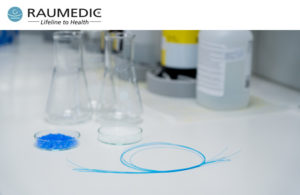
The Helmbrechts, Germany–based of medical-grade plastic compounds — which has its U.S. headquarters in Mills River, N.C. — has tested the new additive for in combination with a base polymer for over six months, finding that it significantly lowers the coefficient of friction.
Comparison studies of extrudates with and without a sliding additive found that the additive didn’t have a significant effect on mechanical and chemical characteristics of the base material, including dimension stability, flow rate and tensile strength.
It is possible to use the additive with thermoplastic elastomers, polyamides, polystyrenes and polyolefins.
“We see tremendous improvement potential for our catheter products because they are easier to introduce into the body thanks to their reduced gliding force,” said Katharina Neumann, the head of materials chemistry at Raumedic. “Existing guidewires can be removed more easily as well.”
Other potential application areas include regional anesthesia, drug delivery including syringe systems, and minimally invasive surgery.
“The additive can be used for all applications in which plastic has to glide well on plastic,” Neumann said in a news release.
The new material combination could also be a low-cost alternative to expensive thermoplastic PTFE.
Radiopaque settings and customized color are also possible with the material.
